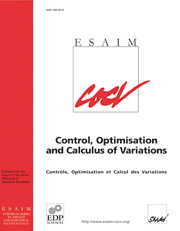Crossref Citations
This article has been cited by the following publications. This list is generated based on data provided by
Crossref.
Šimon Hilscher, Roman
and
Zeidan, Vera
2012.
Oscillation theorems and Rayleigh principle for linear Hamiltonian and symplectic systems with general boundary conditions.
Applied Mathematics and Computation,
Vol. 218,
Issue. 17,
p.
8309.
Bohner, Martin
Kratz, Werner
and
Šimon Hilscher, Roman
2012.
Oscillation and spectral theory for linear Hamiltonian systems with nonlinear dependence on the spectral parameter.
Mathematische Nachrichten,
Vol. 285,
Issue. 11-12,
p.
1343.
Hilscher, Roman Šimon
2014.
Comparison theorems for self‐adjoint linear Hamiltonian eigenvalue problems.
Mathematische Nachrichten,
Vol. 287,
Issue. 5-6,
p.
704.
Šepitka, Peter
and
Šimon Hilscher, Roman
2015.
Principal Solutions at Infinity of Given Ranks for Nonoscillatory Linear Hamiltonian Systems.
Journal of Dynamics and Differential Equations,
Vol. 27,
Issue. 1,
p.
137.
Šepitka, Peter
and
Šimon Hilscher, Roman
2015.
Principal and antiprincipal solutions at infinity of linear Hamiltonian systems.
Journal of Differential Equations,
Vol. 259,
Issue. 9,
p.
4651.
Šepitka, Peter
and
Šimon Hilscher, Roman
2016.
Genera of conjoined bases of linear Hamiltonian systems and limit characterization of principal solutions at infinity.
Journal of Differential Equations,
Vol. 260,
Issue. 8,
p.
6581.
Šepitka, Peter
and
Hilscher, Roman Šimon
2016.
Differential and Difference Equations with Applications.
Vol. 164,
Issue. ,
p.
359.
Elyseeva, Julia
2017.
On symplectic transformations of linear Hamiltonian differential systems without normality.
Applied Mathematics Letters,
Vol. 68,
Issue. ,
p.
33.
Šepitka, Peter
and
Šimon Hilscher, Roman
2017.
Comparative index and Sturmian theory for linear Hamiltonian systems.
Journal of Differential Equations,
Vol. 262,
Issue. 2,
p.
914.
Šepitka, Peter
and
Šimon Hilscher, Roman
2018.
Focal points and principal solutions of linear Hamiltonian systems revisited.
Journal of Differential Equations,
Vol. 264,
Issue. 9,
p.
5541.
Elyseeva, Julia
2018.
The comparative index and transformations of linear Hamiltonian differential systems.
Applied Mathematics and Computation,
Vol. 330,
Issue. ,
p.
185.
Šepitka, Peter
and
Šimon Hilscher, Roman
2019.
Singular Sturmian separation theorems on unbounded intervals for linear Hamiltonian systems.
Journal of Differential Equations,
Vol. 266,
Issue. 11,
p.
7481.
Došlý, Ondřej
Elyseeva, Julia
and
Hilscher, Roman Šimon
2019.
Symplectic Difference Systems: Oscillation and Spectral Theory.
p.
1.
Šepitka, Peter
and
Šimon Hilscher, Roman
2020.
Singular Sturmian comparison theorems for linear Hamiltonian systems.
Journal of Differential Equations,
Vol. 269,
Issue. 4,
p.
2920.
Elyseeva, Julia
2020.
Comparison theorems for conjoined bases of linear Hamiltonian systems without monotonicity.
Monatshefte für Mathematik,
Vol. 193,
Issue. 2,
p.
305.
Šepitka, Peter
and
Šimon Hilscher, Roman
2020.
Sturmian comparison theorems for completely controllable linear Hamiltonian systems in singular case.
Journal of Mathematical Analysis and Applications,
Vol. 487,
Issue. 2,
p.
124030.
Zemánek, Petr
2021.
Eigenfunctions expansion for discrete symplectic systems with general linear dependence on spectral parameter.
Journal of Mathematical Analysis and Applications,
Vol. 499,
Issue. 2,
p.
125054.
Šepitka, Peter
and
Šimon Hilscher, Roman
2022.
Weak disconjugacy, weak controllability, and genera of conjoined bases for linear Hamiltonian systems.
Annali di Matematica Pura ed Applicata (1923 -),
Vol. 201,
Issue. 5,
p.
2121.
Šepitka, Peter
and
Šimon Hilscher, Roman
2023.
Solutions with prescribed numbers of focal points of nonoscillatory linear Hamiltonian systems.
Monatshefte für Mathematik,
Vol. 200,
Issue. 2,
p.
359.
Elyseeva, Julia
Šepitka, Peter
and
Šimon Hilscher, Roman
2023.
Oscillation Numbers for Continuous Lagrangian Paths and Maslov Index.
Journal of Dynamics and Differential Equations,
Vol. 35,
Issue. 3,
p.
2589.


